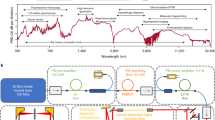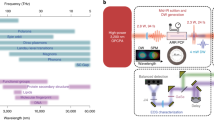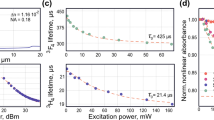Abstract
Extremely short, high-energy pulses are essential in modern ultrafast science. In a seminal paper in 19961, Nisoli and co-workers demonstrated the first intense pulse compression employing a gas-filled hollow-core fibre. Despite the huge body of scientific work on this technology stemming from ultrafast and attosecond research, here we identify an unexplored few-cycle visible-light generation mechanism, which relies on the nonlinear mixing of hollow-core fibre modes. Using a commercially available ytterbium laser, we generate 4.6 fs, 20 μJ pulses centred at around 600 nm (~2 cycles, ~4 GW peak power), ~40 times shorter than the input 175 fs, 1 mJ pulses at 1,035 nm. Our approach thus directly projects few-hundred-femtosecond-long infrared pulses into the single-cycle regime at visible frequencies, without the need for additional post-compression. As a powerful application of our findings, we present a compact, multicolour pump–probe set-up with a temporal resolution of a few optical cycles.
This is a preview of subscription content, access via your institution
Access options
Access Nature and 54 other Nature Portfolio journals
Get Nature+, our best-value online-access subscription
$29.99 / 30 days
cancel any time
Subscribe to this journal
Receive 12 print issues and online access
$209.00 per year
only $17.42 per issue
Buy this article
- Purchase on Springer Link
- Instant access to full article PDF
Prices may be subject to local taxes which are calculated during checkout




Similar content being viewed by others
Data availability
The data that support the plots within this paper and other findings of this study are available from the corresponding authors upon reasonable request.
Code availability
The computer code used in this study is available from the corresponding authors upon reasonable request.
References
Nisoli, M. et al. Generation of high energy 10 fs pulses by a new pulse compression technique. Appl. Phys. Lett. 68, 2793–2795 (1996).
Zewail, A. H. Laser femtochemistry. Science 242, 1645–1653 (1988).
Oliver, T. A. A. Recent advances in multidimensional ultrafast spectroscopy. R. Soc. Open Sci. 5, 171425 (2018).
Wirth, A. et al. Synthesized light transients. Science 334, 195–200 (2011).
Hooker, S. M. Developments in laser-driven plasma accelerators. Nat. Photon. 7, 775–782 (2013).
Cerullo, G. et al. Photosynthetic light harvesting by carotenoids: detection of an intermediate excited state. Science 298, 2395–2398 (2002).
Schoenlein, R. W. et al. The first step in vision: femtosecond isomerization of rhodopsin. Science 254, 412–415 (1991).
Chemla, D. S. & Shah, J. Many-body and correlation effects in semiconductors. Nature 411, 549–557 (2001).
Fork, R. L. et al. Compression of optical pulses to six femtoseconds by using cubic phase compensation. Opt. Lett. 12, 483–485 (1987).
Bohman, S. et al. Generation of 5.0fs, 5.0mJ pulses at 1kHz using hollow-fiber pulse compression. Opt. Lett. 35, 1887–1889 (2010).
Jeong, Y.-G. et al. Direct compression of 170-fs 50-cycle pulses down to 1.5 cycles with 70% transmission. Sci. Rep. 8, 11794 (2018).
Nisoli, M. et al. Toward a terawatt-scale sub-10-fs laser technology. IEEE J. Sel. Topics Quantum Electron. 4, 414–419 (1998).
Robinson, J. S. et al. The generation of intense, transform-limited laser pulses with tunable duration from 6 to 30 fs in a differentially pumped hollow fibre. Appl. Phys. B 85, 525–529 (2006).
Silva, F. et al. Strategies for achieving intense single-cycle pulses with in-line post-compression setups. Opt. Lett. 43, 337–340 (2018).
Cardin, V. et al. 0.42 TW 2-cycle pulses at 1.8 μm via hollow-core fiber compression. Appl. Phys. Lett. 107, 181101 (2015).
Böhle, F. et al. Compression of CEP-stable multi-mJ laser pulses down to 4 fs in long hollow fibers. Laser Phys. Lett. 11, 095401 (2014).
Cerullo, G. et al. Sub-8-fs pulses from an ultrabroadband optical parametric amplifier in the visible. Opt. Lett. 23, 1283–1285 (1998).
Baltuška, A. et al. Visible pulse compression to 4 fs by optical parametric amplification and programmable dispersion control. Opt. Lett. 27, 306–308 (2002).
Odhner, J. H. & Levis, R. J. High-energy noncollinear optical parametric amplifier producing 4 fs pulses in the visible seeded by a gas-phase filament. Opt. Lett. 40, 3814–3817 (2015).
Harth, A. et al. Two-color pumped OPCPA system emitting spectra spanning 15 octaves from VIS to NIR. Opt. Express 20, 3076–3081 (2012).
Brahms, C. et al. Infrared attosecond field transients and UV to IR few-femtosecond pulses generated by high-energy soliton self-compression. Phys. Rev. Res. 2, 043037 (2020).
Travers, J. C. et al. High-energy pulse self-compression and ultraviolet generation through soliton dynamics in hollow capillary fibres. Nat. Photon. 13, 547–554 (2019).
Liu, J. et al. Generation of stable sub-10 fs pulses at 400 nm in a hollow fiber for UV pump-probe experiment. Opt. Express 18, 4664–4672 (2010).
Matsubara, E. et al. Generation of 2.6 fs optical pulses using induced-phase modulation in a gas-filled hollow fiber. J. Opt. Soc. Am. B 24, 985–989 (2007).
Russell, P. S. J. et al. Hollow-core photonic crystal fibres for gas-based nonlinear optics. Nat. Photon. 8, 278–286 (2014).
Alfano, R. R. The Supercontinuum Laser Source: The Ultimate White Light 2nd edn (Springer, 2016).
Wright, L. G. et al. Controllable spatiotemporal nonlinear effects in multimode fibres. Nat. Photon. 9, 306–310 (2015).
Krupa, K. et al. Multimode nonlinear fiber optics, a spatiotemporal avenue. APL Photonics 4, 110901 (2019).
Marcatili, E. A. J. & Schmeltzer, R. A. Hollow metallic and dielectric waveguides for long distance optical transmission and lasers. Bell Syst. Tech. J. 43, 1783–1809 (1964).
Brown, J. M. et al. Analysis of the angular spectrum for ultrashort laser pulses. J. Opt. Soc. Am. B 36, A105–A111 (2019).
Ratner, J. et al. Coherent artifact in modern pulse measurements. Opt. Lett. 37, 2874–2876 (2012).
Manzoni, C. et al. Two-color pump-probe system broadly tunable over the visible and the near infrared with sub-30 fs temporal resolution. Rev. Sci. Instrum. 77, 023103 (2006).
Schmidt, B. E. et al. Highly stable, 54 mJ Yb-InnoSlab laser platform at 0.5 kW average power. Opt. Express 25, 17549–17555 (2017).
Nagy, T. et al. Generation of three-cycle multi-millijoule laser pulses at 318 W average power. Optica 6, 1423–1424 (2019).
Acknowledgements
We would like to thank Natural Sciences and Engineering Research Council of Canada (NSERC) (Collaborative Research and Development (CRD) and Discovery Grants) and Prompt, Québec. J.M.B. acknowledges support from the Air Force Office of Scientific Research under MURI award no. FA9550-16-1-0013. R.M. is affiliated to IFFS as an adjoint faculty.
Author information
Authors and Affiliations
Contributions
R.P. performed the experiments with the support of Y.-G.J., A.R. and L.Z. J.M.B. performed the numerical simulations. A.C., M.B.G. and J.C.T. supervised the numerical simulations. B.E.S. and L.R. conceived the study and supervised its realization. R.M. and F.L. provided technical support. All the authors discussed the experimental results and helped with the preparation of the manuscript.
Corresponding authors
Ethics declarations
Competing interests
The authors declare no competing interests.
Additional information
Peer review information Nature Photonics thanks Daniele Faccio and the other, anonymous, reviewer(s) for their contribution to the peer review of this work.
Publisher’s note Springer Nature remains neutral with regard to jurisdictional claims in published maps and institutional affiliations.
Supplementary information
Supplementary Information
Supplementary Figs. 1–23 and description of the numerical model.
Rights and permissions
About this article
Cite this article
Piccoli, R., Brown, J.M., Jeong, YG. et al. Intense few-cycle visible pulses directly generated via nonlinear fibre mode mixing. Nat. Photon. 15, 884–889 (2021). https://doi.org/10.1038/s41566-021-00888-7
Received:
Accepted:
Published:
Issue Date:
DOI: https://doi.org/10.1038/s41566-021-00888-7
This article is cited by
-
Spectral broadening and nonlinear mode coupling in a gas-filled hollow core capillary
Applied Physics B (2024)
-
Synthesis of ultrafast wavepackets with tailored spatiotemporal properties
Nature Photonics (2022)
-
Physics of highly multimode nonlinear optical systems
Nature Physics (2022)



